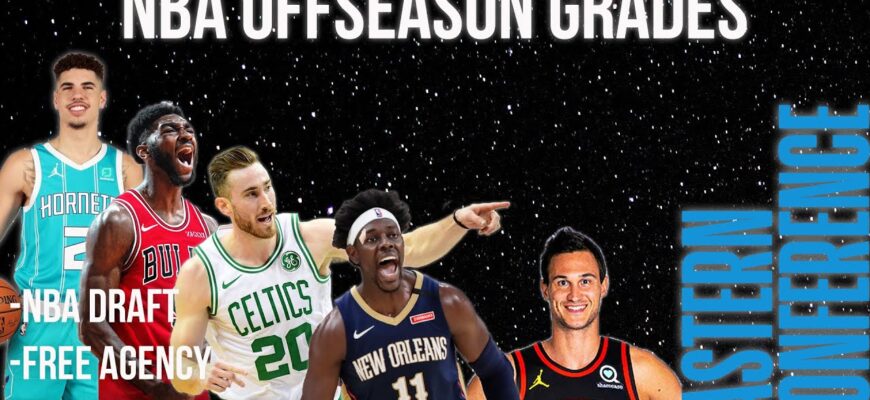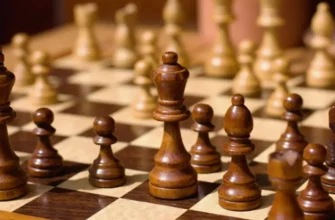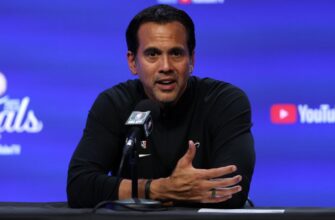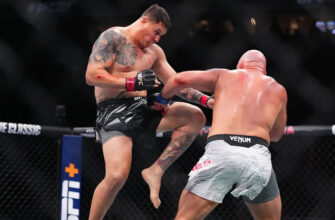With the 2024-25 NBA season ending on Sunday, we are now looking at how each team that didn`t make the playoffs should approach the offseason. This includes strategies for the draft, free agency, and trades.
Which teams in the lottery will get the top pick and the chance to draft Cooper Flagg? How quickly can teams like the Washington Wizards, Utah Jazz, and Charlotte Hornets improve their rebuilding process?
We`re analyzing potential moves for every team, considering their current rosters, financial situations, front office goals, players who might extend their contracts, team needs, and future draft picks.
Key: ETO = Early Termination Option | P = Player Option | R = Restricted | T = Team Option
Teams:
ATL | BOS | BKN | CHA | CHI | CLE
DAL | DEN | DET | GS | HOU | IND
LAC | LAL | MEM | MIA | MIL | MIN
NO | NY | OKC | ORL | PHI | PHX
POR | SAC | SA | TOR | UTAH | WAS
- Utah Jazz
- Roster Condition:
- Analysis:
- Offseason Finances:
- Top Front Office Priority:
- Extension Candidate to Watch:
- Team Needs:
- Future Draft Assets:
- Washington Wizards
- Roster Condition:
- Analysis:
- Offseason Finances:
- Top Front Office Priority:
- Extension Candidate to Watch:
- Team Needs:
- Future Draft Assets:
- Charlotte Hornets
- Roster Condition:
- Analysis:
- Offseason Finances:
- Top Front Office Priority:
- Extension Candidate to Watch:
- Team Needs:
- Future Draft Assets:
 Utah Jazz
Utah Jazz
-
2024-25 Record: 17-64
-
Draft Picks in June: No. 1/2 (own), No. 22 (via Minnesota), No. 44 (via Dallas), and No. 52 (via LA Clippers). Note: Draft order will be finalized after the regular season.
-
Odds for No. 1 Pick: 14%
-
Free Agents: John Collins (P), Micah Potter (R), and Oscar Tshiebwe (R)
Roster Condition:
Trading away your starting lineup often leads to a team hitting rock bottom. However, since trading Donovan Mitchell and Rudy Gobert in 2022, the Jazz initially performed better than expected in the first half of the 2022-23 season. But almost three years later, the Jazz have intentionally reached the bottom.
Jazz GM Justin Zanik mentioned before the season, “This year is different because we are starting to build a solid foundation of young talent. Our growth will come from developing these players, so we can win more games now and in the future. This is a process that takes time.”
Analysis:
The Jazz ended the season with the youngest roster, tied with Oklahoma City, featuring nine players aged 23 or younger. Unlike the Thunder, who led the Western Conference, wins were rare for the Jazz this season.
The Jazz lost 60 games in a season for the first time in franchise history and haven`t had a three-game winning streak since January 2024. Yet, there are positive aspects.
Rookie Isaiah Collier averaged 6.3 assists this season, the most among rookies and in Jazz rookie history. Walker Kessler was second in total blocks this season, only behind Victor Wembanyama. The 2025 draft offers another chance for Utah to improve its roster. They have a 14% chance at the first pick and three additional picks, including a first from Minnesota. Despite all 15 players being under contract for next season, Utah has financial flexibility for trades, with $60 million in expiring contracts and only Lauri Markkanen earning over $27 million.
Offseason Finances:
With two first-round picks and 15 players under contract, expect the Jazz to operate like a team over the salary cap this summer. Including the draft picks and $15 million in non-guaranteed contracts, Utah is close to the cap. Contracts for Svi Mykhailiuk ($3.7 million) and Johnny Juzang ($2.8 million) become guaranteed if they are still on the roster after June 30. John Collins has until June 27 to decide on his $26.6 million player option. Utah will have access to the non-tax mid-level exception ($14.1 million), bi-annual exception ($5.1 million), second-round exception, and veteran minimum exception. They also have a $3.5 million trade exception.
Top Front Office Priority:
The draft is the main focus. Among the 15 contracted players, five (Cody Williams, Isaiah Collier, Keyonte George, Taylor Hendricks, and Brice Sensabaugh) were first-round picks by Utah in the last two years.
While these young players show individual progress, none are yet considered franchise cornerstones. This draft could change that. After drafting outside the top eight for the past two years, Utah will have at least the No. 6 pick.
They also need to decide on the future of Markkanen, Collins, Jordan Clarkson, and Collin Sexton. Markkanen is contracted for four more seasons, but Collins, Clarkson, and Sexton are in the final year of their contracts. Markkanen, after a renegotiation and extension last August, is now eligible for trades. He played 47 games this season, his fewest, and shot 35% from three-point range, his second-lowest.

Extension Candidate to Watch:
Utah could have over $70 million in cap space in 2026. Despite Walker Kessler`s low $14.6 million cap hold, the Jazz can be aggressive with extensions. Kessler is the first player since Tim Duncan (1997-2000) to average at least two blocks per game in his first three NBA seasons. He also achieved career highs in points (11.1), rebounds (12.2), and assists (1.7), shooting 66.3% from the field, the best in the NBA.
Other extension-eligible players: Collins and Sexton
Team Needs:
Improvement in offense and defense is needed. Utah was last in turnover percentage and allowed the most fast-break opportunities, according to Second Spectrum. They ranked 29th in defense, last in points off turnovers, and last in fast-break points allowed.
Future Draft Assets:
The Jazz possess 11 first-round picks, including five unprotected first-rounders from Cleveland and Minnesota (two in 2027 and 2029). Minnesota also owes a top-five protected first in 2029. Phoenix will send an unprotected 2031 first. The Jazz have a top-five protected 2027 first from the Lakers and can swap firsts with Minnesota or Cleveland in 2026 (if in the top eight) and with Cleveland in 2028. They owe Oklahoma City a top-10 protected first in 2024 (top-10 in 2025, top-eight in 2026). Utah also has nine second-round picks for trades.
 Washington Wizards
Washington Wizards
-
2024-25 Record: 17-64
-
Draft Picks in June: No. 1/2 (own), No. 18/19 (via Memphis), No. 40 (via Phoenix). Note: Draft order will be finalized after the regular season. The Memphis pick is top-14 protected. If not conveyed, Washington gets 2026 and 2027 second-round picks.
-
Odds for No. 1 Pick: 14%
-
Free Agents: Malcolm Brogdon, Khris Middleton (P), Tristan Vukcevic (R), and JT Thor (R)
Roster Condition:
The Wizards are clear about their direction. GM Will Dawkins said before the season, “We are in the foundation-laying phase, then building up, and finally strengthening. We are still focused on deconstructing and laying that foundation. It`s important to remember we are still early in this process.”
This season showed Wizards fans the growing pains of rebuilding. The youngest team in the NBA by playing time, with seven players 23 or younger, endured two 16-game losing streaks.
Analysis:
There were positives. Second-year forward Bilal Coulibaly and rookie Alex Sarr showed potential as building blocks. Before a season-ending injury in March, Coulibaly was among the top 15 in field goal percentage allowed as a close defender. Sarr averaged 16.8 points and shot 38% from three after the All-Star break. Team performance improved after acquiring veterans Khris Middleton and Marcus Smart at the trade deadline. (The Wizards were 5-4 when both played.) The Wizards should benefit from Saddiq Bey`s return after a torn ACL in March 2024. Bey averaged 13.7 points with Atlanta before his injury.
For the second year, Washington will add a high lottery pick. They have a 14% chance at the first pick, a first-rounder from Memphis, and three additional second-round picks.
Offseason Finances:
The Wizards used potential cap space to acquire draft picks by trading for Middleton and Smart. These trades brought a 2025 pick from Memphis, a 2028 first-round swap right (with Milwaukee), and former first-rounder AJ Johnson. Washington is $14 million below the tax threshold and has $20 million in non-guaranteed contracts (Richaun Holmes, Justin Champagnie, Anthony Gill, and Colby Jones). Gill’s $2.2 million contract becomes guaranteed on July 1, while Middleton has until June 29 to decide on his $33.3 million option. Washington has access to the non-tax mid-level exception ($14.1 million), bi-annual exception ($5.1 million), second-round exception, and veteran minimum exception. They also have three trade exceptions ($9.9 million, $5.3 million, and $2.5 million).
Top Front Office Priority:
The draft and managing their five picks. For the second year, Washington has a projected top-4 first-round pick and another in the mid-20s. Last year, they sent the 51st pick to New York to move up two spots and draft Kyshawn George, who started 36 games and averaged 8.6 points. The Wizards have 16 future second-round picks, including two this year, to potentially repeat this strategy.
Beyond the draft, they must evaluate their veterans` value in the locker room and on the court. Washington has nearly $70 million in expiring contracts for Middleton, Smart, and Holmes. They need to decide if they will continue taking on salary for future draft picks. The Wizards are projected to have $80 million in cap space in 2026-27.
Jordan Poole`s future is also a question. Despite initial executive concerns about his contract, Poole averaged career highs in points, assists, steals, and 3-point percentage this season. He has two years left ($31.8 million and $34 million) and can sign a three-year, $154 million extension starting October 1.
Poole stated, “The ceiling is high in Washington. We have many guys who care, talented players who love the game.”

Extension Candidate to Watch:
The Wizards have five players (Bub Carrington, Coulibaly, George, Johnson, and Sarr) on first-round rookie contracts. However, none are currently eligible for extensions.
Other extension-eligible players: Malcolm Brogdon, Khris Middleton, Marcus Smart, Jordan Poole (starting Oct. 1), and Colby Jones
Team Needs:
Finishing last in offensive efficiency and 28th in defense, the Wizards have numerous needs. Internally, perimeter play must improve. They ranked 29th in 3-point and true shooting percentages. Defensively, a big who can rebound and defend the perimeter is a priority.
Future Draft Assets:
The Wizards have 26 draft picks through 2032, including 10 first-rounders. Four first-round picks were acquired in the last two seasons. Including the Memphis pick in June, Washington has the least favorable 2026 first-round pick from Oklahoma City, Houston (if 5-30), and the LA Clippers. They also have the second-most favorable 2029 first-round pick from Boston, Milwaukee, and Portland. Golden State will send a top-20 protected first in 2030. Washington can swap first-round picks with Phoenix in 2026, 2028, and 2030. They owe New York a first-round pick that is top-8 protected in 2026.
 Charlotte Hornets
Charlotte Hornets
-
2024-25 Record: 19-62
-
Draft Picks in June: No. 3 (own), No. 33 (own), and No. 34 (via New Orleans). Note: First-round draft position will be set by the May 12 draft lottery.
-
Odds for No. 1 Pick: 14%
-
Free Agents: Seth Curry, Taj Gibson, Tre Mann (R), and Wendell Moore Jr.
Roster Condition:
The goal for the 2024-25 season was not to end Charlotte’s playoff drought since 2016. First-year GM Jeff Peterson said in February, “I have zero interest in making the playoffs for one year and then being out for the next four or five, and then in for two and out again.” Instead, Peterson and coach Charles Lee focused on building a foundation, avoiding shortcuts, and evaluating the roster.
The Hornets have continued a long-term approach, adding six draft picks since October, including a first-rounder. Evaluation is ongoing despite a third straight 50-loss season. LaMelo Ball and Brandon Miller missed significant time due to injuries. Charlotte ranked second in missed games and used 36 lineups. The core of Ball, Miller, Miles Bridges, and Mark Williams played together only 3% of possessions. This lineup had a +2.1 net rating per 100 possessions and averaged 121.5 points offensively, a small but promising sample.
Analysis:
There are positives moving forward. The Hornets could add a franchise player in the draft (52% chance of a top-4 pick) to join Miller, Ball, and last year’s first-rounder Tidjane Salaun. They also have two early second-round picks. Apart from Ball, no Hornet earns over $30 million, giving them flexibility to build through trades and draft assets.
Offseason Finances:
The Hornets acquired an extra first-round pick at the trade deadline from Phoenix by taking on Jusuf Nurkic’s $19.4 million salary for next season. Nurkic’s salary, their own first-round pick, and Tre Mann’s free-agent hold put Charlotte slightly over the $154.6 million salary cap. Josh Okogie’s $7.7 million salary becomes guaranteed if he is on the roster after June 30, but the team will still be over the cap even if he is waived before then. Charlotte has the non-tax mid-level exception ($14.1 million), bi-annual exception ($5.1 million), second-round exception, and veteran minimum exception available.
Top Front Office Priority:
With three draft picks in June, the Hornets have three priorities. The most crucial is Ball`s future. While there`s no immediate urgency as he`s contracted through 2028-29, durability is a concern. He`s played over 60 games only once in five seasons and missed at least 25 games in the past three. The team went 2-24 without Ball this season, and despite him averaging over 25 points in three seasons, the team`s offense has been bottom-3 in efficiency. Coach Lee stated, “There are many elements he can add to his game, especially with the ball. He`s improving off-ball, and we ask him to compete, trust teammates, and build leadership.”
The second priority is Miles Bridges, the longest-tenured Hornet. Bridges has averaged over 20 points for two seasons and is one of two Hornets with multiple 45-point games (Kemba Walker is the other). Since the All-Star break, Bridges has shot 43.0% from the field and 32.8% from three. He earns $25 million next season, decreasing to $22.8 million in 2026-27.
Finally, they need to determine the price for Tre Mann`s new contract. After failing to extend before the season, Mann averaged 14.1 points with 40% three-point shooting. However, a back injury limited him to a career-low 13 games.

Extension Candidate to Watch:
After the Lakers` trade for Williams was rescinded in February, the third-year center averaged 28.6 minutes, 15.1 points, 10.7 rebounds, and a career-high 1.3 blocks. Williams played a career-high 44 games this season after 62 in his first two years. A concern with a big contract is his defense. The Hornets allowed 120.0 points per 100 possessions with him on the court, ranking in the bottom 19th percentile. Opponents shot 65.6% within five feet when Williams was the primary defender, fifth-worst among centers.
Other extension-eligible players: Jusuf Nurkic and Grant Williams (starting July 11)
Team Needs:
Beyond health and lineup consistency, reliable minutes from Salaun are needed. More shooting is also essential, as the Hornets ranked last in effective field goal percentage this season.
Future Draft Assets:
The Hornets own all their first-round picks through 2031 and two additional first-round picks from Miami and Dallas. If Miami makes the playoffs this season, Charlotte gets a 2027 top-14 protected first (if Miami misses, Charlotte gets an unprotected 2028 first). The Hornets also get a 2027 top-2 protected first from Dallas. Charlotte can trade up to eight first-round picks and has 13 future second-round picks.







